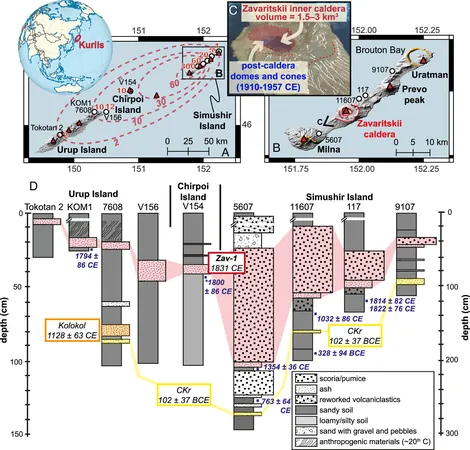
Uncovering the Secrets of a 200-Year-Old Volcanic Eruption – A Shocking Discovery!
2025-01-02
Author: John Tan
Groundbreaking Revelation
In a groundbreaking revelation, researchers from the University of St Andrews have finally solved the enduring mystery surrounding a cataclysmic volcanic eruption that occurred nearly 200 years ago. The 1831 eruption, which unleashed vast amounts of sulfurous gases into the atmosphere, resulted in a dramatic global temperature drop of approximately 1°C. This sudden cooling triggered severe crop failures and famines across numerous regions, alarming communities worldwide.
Historical Impact
Historically, the aftermath of this eruption inspired renowned composer Felix Mendelssohn to document the harrowing weather conditions during his 1831 Alpine journey. In his accounts, he lamented, "Desolate weather, it has rained again all night and all morning; it is as cold as in winter, there is already deep snow on the nearest hills…"
The Culprit Identified
Despite the eruption's significant climatic impact, the volcano responsible remained unknown, leading to a vigorous debate among scientists for nearly two centuries. But now, thanks to the innovative research led by Dr. Will Hutchison from the School of Earth and Environmental Science, the mystery has been unraveled. Their study, published in the prestigious journal Proceedings of the National Academy of Sciences, reveals that the team identified the Zavaritskii volcano on the remote Simushir Island, part of the strategically disputed Kuril Islands, as the eruption's culprit.
Research Methodology
Dr. Hutchison and his team's meticulous work involved analyzing ice core samples from the 1831 eruption, showcasing their latest techniques to extract minuscule ash particles – comparable to one-tenth the diameter of a human hair. In a labor-intensive process involving collaboration with Japanese and Russian colleagues, they expertly matched the ash deposits to confirm their findings.
Scientific Breakthrough
"In the lab, when we compared the two ash samples – one from the Zavaritskii volcano and another from the ice core – it was a true eureka moment. I struggled to believe the results were identical," Dr. Hutchison remarked. This significant discovery underscores the Kuril Islands as an under-explored volcanic hotspot with the capacity to influence global climate patterns.
Legacy of the Zavaritskii Volcano
Furthermore, the legacy of the Zavaritskii volcano extends beyond this eruption. During the Cold War, Simushir served a pivotal role as a clandestine Soviet nuclear submarine base, hidden within a flooded volcanic crater—akin to a plot from a James Bond film. Today, the islands remain under Russian control and are strategically vital.
Call to Action
Dr. Hutchison's research stresses the importance of monitoring such remote volcanic regions, emphasizing the unpredictability of future volcanic events that could mirror the catastrophic impact of the 1831 eruption. "As scientists and as a society, we must deliberate on how to coordinate an international response to future eruptions capable of triggering similar climatic consequences," he said.
Conclusion
This newly uncovered knowledge not only sheds light on a historical geological event but also serves as a stark reminder of the potential dangers posed by Earth's volcanic activity. As researchers continue to unravel the secrets of our planet, one can only wonder – what other mysteries await discovery?
 Brasil (PT)
Brasil (PT)
 Canada (EN)
Canada (EN)
 Chile (ES)
Chile (ES)
 Česko (CS)
Česko (CS)
 대한민국 (KO)
대한민국 (KO)
 España (ES)
España (ES)
 France (FR)
France (FR)
 Hong Kong (EN)
Hong Kong (EN)
 Italia (IT)
Italia (IT)
 日本 (JA)
日本 (JA)
 Magyarország (HU)
Magyarország (HU)
 Norge (NO)
Norge (NO)
 Polska (PL)
Polska (PL)
 Schweiz (DE)
Schweiz (DE)
 Singapore (EN)
Singapore (EN)
 Sverige (SV)
Sverige (SV)
 Suomi (FI)
Suomi (FI)
 Türkiye (TR)
Türkiye (TR)
 الإمارات العربية المتحدة (AR)
الإمارات العربية المتحدة (AR)